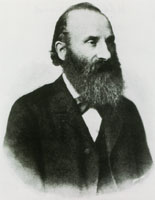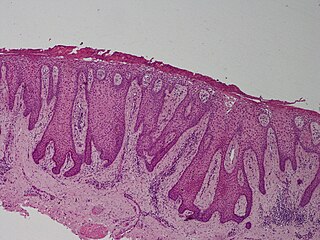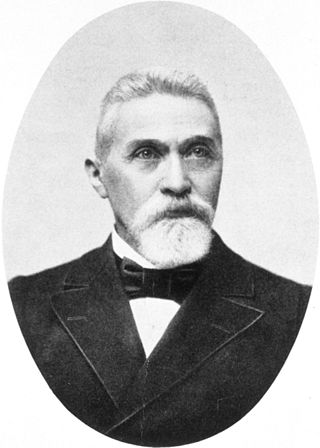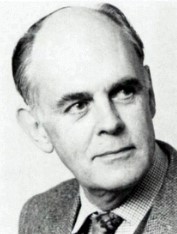The year 1926 in science and technology involved some significant events, listed below.

A seborrheic keratosis is a non-cancerous (benign) skin tumour that originates from cells, namely keratinocytes, in the outer layer of the skin called the epidermis. Like liver spots, seborrheic keratoses are seen more often as people age.

Actinic keratosis (AK), sometimes called solar keratosis or senile keratosis, is a pre-cancerous area of thick, scaly, or crusty skin. Actinic keratosis is a disorder of epidermal keratinocytes that is induced by ultraviolet (UV) light exposure. These growths are more common in fair-skinned people and those who are frequently in the sun. They are believed to form when skin gets damaged by UV radiation from the sun or indoor tanning beds, usually over the course of decades. Given their pre-cancerous nature, if left untreated, they may turn into a type of skin cancer called squamous cell carcinoma. Untreated lesions have up to a 20% risk of progression to squamous cell carcinoma, so treatment by a dermatologist is recommended.

Palmoplantar keratodermas are a heterogeneous group of disorders characterized by abnormal thickening of the stratum corneum of the palms and soles.
Dermatopathology is a joint subspecialty of dermatology and pathology or surgical pathology that focuses on the study of cutaneous diseases at a microscopic and molecular level. It also encompasses analyses of the potential causes of skin diseases at a basic level. Dermatopathologists work in close association with clinical dermatologists, with many possessing further clinical training in dermatology.
Keratoderma is a hornlike skin condition.

Lentigo maligna is where melanocyte cells have become malignant and grow continuously along the stratum basale of the skin, but have not invaded below the epidermis. Lentigo maligna is not the same as lentigo maligna melanoma, as detailed below. It typically progresses very slowly and can remain in a non-invasive form for years.

Epidermodysplasia verruciformis (EV) is a skin condition characterised by warty skin lesions. It results from an abnormal susceptibility to HPV infection (HPV) and is associated with a high lifetime risk of squamous cell carcinomas in skin. It generally presents with scaly spots and small bumps particularly on the hands, feet, face and neck; typically beginning in childhood or in a young adult. The bumps tend to be flat, grow in number and then merge to form plaques. On the trunk, it typically appears like pityriasis versicolor; lesions there being slightly scaly and tan, brown, red or looking pale. On the elbows, it may appear like psoriasis. On the forehead, neck and trunk, the lesions may appear like seborrheic keratosis.

Heinrich Koebner ; was a German-Jewish dermatologist born in Breslau.

Karl Herxheimer was a German-Jewish dermatologist who was a native of Wiesbaden.
Adolf Jarisch was an dermatologist from the Austro-Hungarian Empire who specialized in the care of venereal disease. The Jarisch-Herxheimer reaction, an inflammatory response that he noted following treatment for syphilis, is partially named after him. Jarisch was the father of a noted pharmacologist, Adolf Jarisch Jr.

Cutaneous horns, also known by the Latin name cornu cutaneum, are unusual keratinous skin tumors with the appearance of horns, or sometimes of wood or coral. Formally, this is a clinical diagnosis for a "conical projection above the surface of the skin." They are usually small and localized but can, in very rare cases, be much larger. Although often benign, they can also be malignant or premalignant.

Clear cell acanthoma is a benign clinical and histological lesion initially described as neoplastic, which some authors now regard as a reactive dermatosis. It usually presents as a moist solitary firm, brown-red, well-circumscribed, 5 mm to 2 cm nodule or plaque on the lower extremities of middle-aged to elderly individuals. The lesion has a crusted, scaly peripheral collarette and vascular puncta on the surface. It is characterized by slow growth, and may persist for years. The clinical differential diagnosis includes: dermatofibroma, inflamed seborrheic keratosis, pyogenic granuloma, basal-cell carcinoma, squamous cell carcinoma, verruca vulgaris, psoriatic plaque, and melanoma.
Electrodesiccation and curettage is a medical procedure commonly performed by dermatologists, surgeons and general practitioners for the treatment of basal cell cancers and squamous cell cancers of the skin. It provides desiccation, coagulation/cauterization, and curettage to remove lesions from the skin.

Johannes Fabry was a German dermatologist.

Philipp Josef Pick was a dermatologist from the Austro-Hungarian Empire.

Arthur James Rook FRCP was a leading British dermatologist and the principal author of Rook's Textbook of Dermatology (1968), known as "Rook's", which reached its ninth edition in 2016.

Max Jessner was a German dermatologist and university professor. In 1928 he travelled to Buriat-Mongolia on an expedition to study syphilis and the effects of the anti-syphilitic drug Salvarsan. After escaping Nazi occupied Europe in the mid-1930s, he settled in New York. Jessner is remembered for the development of the chemical peel known as Jessner's solution and the description of Jessner-Kanof disease.

Archives of Dermatological Research, published by Springer Science+Business Media, is a peer-reviewed medical journal that focuses on skin disease. It was established as the Archiv für Dermatologie und Syphilis in 1869 by Heinrich Auspitz and Philipp Josef Pick. Springer acquired the journal in 1921 and renamed it the Archiv für klinische und experimentelle Dermatologie und Syphilis. In the 1950s it followed the general trend to drop its link to sexually transmitted infections in its title. It became the Archiv für Dermatologische Forschung in 1971 before obtaining its current name in 1975.
















